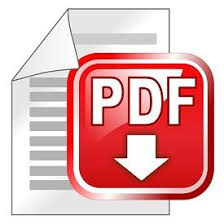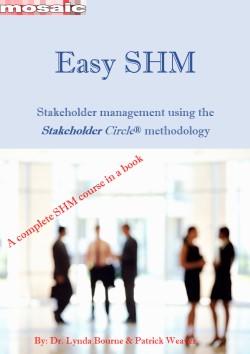Location:
PMKI > Stakeholder
Management > The Stakeholder Circle
Methodology.


- The Stakeholder
Circle® Methodology Overview
- Applying the Stakeholder
Circle® Methodology
- Stakeholder
Circle Methodology - Stage 1. Identification
- Stakeholder
Circle Methodology - Stage 2. Prioritization
- Stakeholder
Circle Methodology - Stage 3. Visualization
- Stakeholder
Circle Methodology - Stage 4. Engagement
- Stakeholder
Circle Methodology - Stage 5. Monitor &
Manage
- Easy Stakeholder Management
- The ESEI Stakeholder
Management Series
- Stakeholder Circle Books
Other related sections of the PMKI:
- Stakeholder Circle®
Tools Help
- Advanced Stakeholder
Engagement
- The Stakeholder Relationship
Management Maturity Model (SRMM®).

The Stakeholder Circle® is based on the premise that a business activity, program of works, or project, can only operate successfully with the informed consent of its stakeholder community. This community comprises individuals and groups, each with a different potential to influence the activity’s outcome.
The Stakeholder Circle® has been devised to offer a mechanism for assessing the relative influence of each of the key stakeholders and planning ways to engage with and manage their expectations and/or contributions. The benefit of using this methodology is derived in part from the analysis process itself as well as from the ease with which the influence of key stakeholder’s on the project can be judged once the Stakeholder Circle is complete.
The analysis is centered on the manager responsible for the successful completion of the activity (for example the project manager) and seeks to engage with the stakeholder community to the benefit of both the stakeholders and the activity. The tools facilitate the regular updating of this assessment as the stakeholder community changes to reflect the dynamic nature of the project and its relationships. Changes and trends are tracked over time to help the team identify which engagement strategies are working and which need reviewing.
To understand the research
behind the methodology and tool-set click through to Dr.
Lynda Bourne's research thesis: Project Relationship
Management and the Stakeholder Circle®
 The
Stakeholder Work Sheet (SWS) is a sophisticated Excel
spreadsheet built to implement the Stakeholder Circle®
methodology - see
more on the SWS.
The
Stakeholder Work Sheet (SWS) is a sophisticated Excel
spreadsheet built to implement the Stakeholder Circle®
methodology - see
more on the SWS.
PP: Concepts for a Stakeholder Circle Management Tool. This is the original 2002 conference paper outlining the concept of the Stakeholder Circle, it is included for historical reference only. Following on, the prototype tool was used in Dr. Bourne's thesis and then commercialized as a practical aid to stakeholder engagement.
PP: The Stakeholder Circle - Tool Description. The Stakeholder Circle® offers a mechanism for assessing the relative importance of each of the key stakeholders in a project. Stakeholders are weighted according to the three characteristics and the assessments are melded into a single diagram.
The Stakeholder Circle® has been designed to put stakeholders on the management radar. It incorporates a proven methodology supported by a robust, easy to use tool that guides you through five easy steps to:
The five phases of the methodology are explained in more detail below. The SRMM® model designed to help baseline and grow your organization’s Stakeholder Management Maturity.
As you work through the five stages outlined below, practical experience shows the use of facilitated workshops significantly enhances the outcomes from applying the Stakeholder Circle methodology. Participants should include:
The identification of a business unit, or project’s, stakeholders to create a list of those who are impacted by the work or will impact the work, positively or negatively. The list is developed by the team and is input to the Stakeholder Circle tool. The tool guides the collection of other information including the project role of each stakeholder, what they require from the project, and their significance to the project
Identification can be done through brainstorming or any other process commonly used in the organization. After a set of stakeholders have been identified, they need to be categorized into:
The process of reaching agreement on these categories will often require the team to negotiate an acceptable outcome. This is followed by identifying what each stakeholder requires from the project as well as the significance of the stakeholder to the project. This information is entered into the Stakeholder Circle and validated. Once complete, the next step ‘prioritization’ of the identified stakeholders can commence. For more information see: Stakeholder Circle Methodology - Identification
The assessment of each stakeholder’s importance to the project is based on ratings from the identification team members of each stakeholder’s perceived power, proximity and urgency. These assessments are combined within the tool to produces an ‘index’ for each stakeholder. The stakeholders are then ranked based on their ‘index’ (the higher the index value, the higher the priority) to produce a prioritized list of stakeholders. To develop the 'circle', Stakeholders are weighted according to the three characteristics.
Power: Some stakeholders (either alone or operating as a group) can terminate the project using their own power, other stakeholders have the power to change or damage the project but cannot on their own cause it to be cancelled or fail – this is the power axis in the stakeholder circle.
Proximity: This aspect considers how closely a stakeholder is associated with the day-to-day running of the project. The center of the diagram represents the project. The space between the two circles represents the sphere of influence of the project on its whole stakeholder community. The proximity of a stakeholder to the project is represented by how close their segment is to the project in the center.
Urgency / Importance: The width of the arc represents the amount of urgency or importance attributed to a stakeholder from the teams perspective (ie, how likely the stakeholder is to use its power), the wider the segment, the greater the importance.
For more information see: Stakeholder Circle Methodology - Prioritization
While the ranked list of all stakeholders is used to develop the communication plan, the top 15 stakeholders are mapped into a symbolic stakeholder community, depicting their relative importance through color coding, and the size and placement of the segments of the Stakeholder Circle. This diagram provides valuable pictorial information to assist in understanding the stakeholder community for that phase of the project. Categorization and charting of key stakeholders holds the key to targeting the right stakeholders at the right time in the life of the project and providing them with the right level of engagement, information and communication. For more information see: Stakeholder Circle Methodology - Visualization
Next, the project team need to ensure that the expectations of key stakeholders are understood, acknowledged, and managed. The software supports the assessment of each stakeholder’s support for the project (either positive or negative) as well as their receptiveness to messages about the project. This information provides the foundation for the development of appropriate responses and a tailored communication plan.
The resulting strategy defines for each stakeholder the tailored messages most likely to be effective communications; including who, what, when and how they will be delivered. For more information see: Stakeholder Circle Methodology - Engagement
Project managers must then convert the strategy into action! This involves integrating the communication plan into the project schedule and reporting on it through team meetings and regular reports. Our Comm-Plan spreadsheet is designed to assist with the management of the communication effort (see more on the Comm-Plan SS).
To maintain currency, the stakeholder assessment process may have to be repeated in whole, or in part, at regular intervals. The project team should update their assessment, particularly as the project progresses through the phases of its lifecycle or as the stakeholder community changes to reflect the dynamic nature of the project’s many relationships. Through review and re-assessment of a project’s stakeholder community, a history of stakeholder involvement and importance, and decisions made about their engagement is maintained; providing a means to monitor the effectiveness of engagement strategy and communications over time.
For more information see: Stakeholder Circle Methodology - 5. Monitor & Manage.
 Easy
SHM is a self-paced course, supported by Mosaic Project
Services Pty Ltd, focused on implementing the Stakeholder
Circle methodology & tools.
Easy
SHM is a self-paced course, supported by Mosaic Project
Services Pty Ltd, focused on implementing the Stakeholder
Circle methodology & tools.
Publication scheduled for Q3 2022
 The ESEI (pronounced
easy) series of 14 articles provides an overview of
effective stakeholder engagement and an introduction to
stakeholder theory. It is designed as a starting point for
people interested in developing stakeholder management and
stakeholder engagement skills. The articles maps out the
key components of the ESEI stakeholder management approach
and show how they support: Ed Freeman’s ‘Stakeholder
Theory’, an organizations commitment to both the GRI
Sustainability Reporting Guidelines and ISO 26000,
and offer a cost effective way to enhance the probability
of project, program and organizational success.
The ESEI (pronounced
easy) series of 14 articles provides an overview of
effective stakeholder engagement and an introduction to
stakeholder theory. It is designed as a starting point for
people interested in developing stakeholder management and
stakeholder engagement skills. The articles maps out the
key components of the ESEI stakeholder management approach
and show how they support: Ed Freeman’s ‘Stakeholder
Theory’, an organizations commitment to both the GRI
Sustainability Reporting Guidelines and ISO 26000,
and offer a cost effective way to enhance the probability
of project, program and organizational success.
Art: ESEI Stakeholder Management Introduction. Using the Effective Stakeholder Engagement Initiative (ESEI™ - pronounced easy) is probably the quickest way to create an organizational culture focused on achieving success based on mutually beneficial stakeholder engagement
Art: Stakeholder Theory. ‘Stakeholder theory’ is a specific approach to recognizing and dealing with stakeholders, based on the concept of stakeholder developed by Ed Freeman.
Art: Why effective stakeholder management is free. Stakeholder engagement is not an overhead and it is not discretionary! It is impossible to deliver a successful project without effectively engaging with your stakeholder community.
Art:
Stakeholders and Risk. Successful risk
management requires effective stakeholder management and
the stakeholder’s perceptions of project success or
failure is intrinsically linked to effective risk
management. (republished in Russian: Project and
Program Management Journal
Vol. 43, No. 3, pp. 212-217 - download the article)
Art: Stakeholder Identification and Prioritization. ESEI stakeholder management benefits from knowing who is in the community, understanding who is important, and deciding what do you need to do craft a successful outcome.
Art: Understanding and visualizing your stakeholder community. Making effective use of stakeholder data requires its transformation into information that can be used to support decision making and action.
Art: Assess Your Stakeholders’ Attitudes. Successful project delivery is helped when stakeholders have the right attitude towards you and your work.
Art: Monitoring the ‘health’ of your stakeholder community. You need to measure the effectiveness of your communications, make adjustments as needed, and also look for the emergence of unexpected changes in the stakeholder community.
Art: The three types of stakeholder communication. A strategic approach to communication using the three general classes of communication; reporting, project relations and directed communication at the right times, to influence the right stakeholders in the best way to achieving a successful outcome.
Art: Communication planning. Communication planning is an essential element in crafting a communication strategy that will work to support the success of the project.
 Our
Communication
Worksheet is a practical Excel template for
establishing and monitoring the routine reporting and
communication requirements of a project or program (see
more).
Our
Communication
Worksheet is a practical Excel template for
establishing and monitoring the routine reporting and
communication requirements of a project or program (see
more).
Art: Communicating for effect. Every communication should be focused on achieving a desired effect on the person’s attitude or behaviour.
Art: Stakeholder Management is no longer optional. In many situations effective stakeholder management is becoming a mandated necessity.
Art: The SRMM® model for stakeholder management maturity and governance. The Stakeholder Relationship Maturity Model (SRMM®) has been designed to facilitate the transition of an organization to their desired level of stakeholder engagement capability and maturity in a structured way.
Art: ESEI Stakeholder Management Conclusion. This series offers a tested framework to create an organizational culture focused on achieving success based on mutually beneficial stakeholder engagement.
Books authored by Dr. Lynda Bourne. Click through to the relevant book page:
 Making
Projects Work: Effective Stakeholder and
Communication Management. Dr.
Lynda Bourne: Projects are performed by people for
people, with the key determinants of success being the
relationships between project teams and project
stakeholders. This web of relationships will either enable
or obstruct the flow of information between people and, as
a consequence, will largely determine project success or
failure. See more.
Making
Projects Work: Effective Stakeholder and
Communication Management. Dr.
Lynda Bourne: Projects are performed by people for
people, with the key determinants of success being the
relationships between project teams and project
stakeholders. This web of relationships will either enable
or obstruct the flow of information between people and, as
a consequence, will largely determine project success or
failure. See more.
 Advising
Upwards: A Framework for Understanding and
Engaging Senior Management Stakeholders. Dr.
Lynda Bourne: Building, and managing, relationships
with senior (upwards) stakeholders is essential for
success. This requires the activity manager to be skillful
at building and maintaining robust relationships, focused
on engaging the support of senior executives,
understanding their expectations and managing them through
targeted communication. See
more.
Advising
Upwards: A Framework for Understanding and
Engaging Senior Management Stakeholders. Dr.
Lynda Bourne: Building, and managing, relationships
with senior (upwards) stakeholders is essential for
success. This requires the activity manager to be skillful
at building and maintaining robust relationships, focused
on engaging the support of senior executives,
understanding their expectations and managing them through
targeted communication. See
more.
 Stakeholder
Relationship Management A Maturity Model for
Organisational Implementation. Dr.
Lynda Bourne: This book provides the 'road map'
needed to help organizations achieve effective stakeholder
engagement in two ways. Firstly, it is a ‘how-to’ book,
secondly, it is a guidebook for assessing the current
maturity of an organization. See
more.
Stakeholder
Relationship Management A Maturity Model for
Organisational Implementation. Dr.
Lynda Bourne: This book provides the 'road map'
needed to help organizations achieve effective stakeholder
engagement in two ways. Firstly, it is a ‘how-to’ book,
secondly, it is a guidebook for assessing the current
maturity of an organization. See
more.